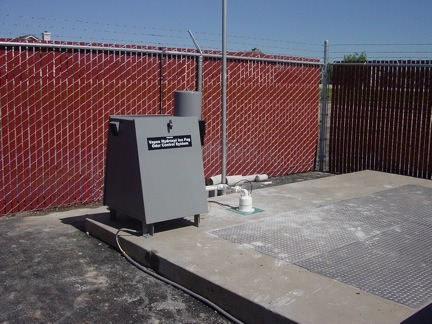Ozone and Oxygen ionization
The Ozone (O3) and Oxygen Ionization (OH–) technology utilizes continuously generated ozone, air and water that are dispersed through an atomizing nozzle to create a fine water mist (or fog) of absorbed ozone with resulting hydroxyl ion in the mist. The mist is typically sprayed into an enclosed structure, such as a covered wet well, to react with H2S and other odorous compounds in the structure headspace for odor control purposes. The structure functions as the reaction chamber.
Ozone & Oxygen Ionization
Ozone is a powerful oxidant that may oxidize H2S, with byproducts of sulfur, water, and oxygen. The ozone molecules will either react directly with the odorous compounds or react with the water particles to form hydroxyl ions, which are commonly used as a bactericide.
Ozone must be produced on-site, because it is an unstable compound of oxygen and cannot be stored. The generator must be located close to the injection point because of the very short half-life of ozone. The process requires intimate mixing of the ozone and hydroxyl ion mist with the odorous air to be effective.
Ozone treatment has been effective in some cases for treatment of hydrogen sulfide. It is not proven effective on ammonia, acetic acid, saturated hydrocarbons, or other organic compounds.
Applicable treatment processes include treatment plant headworks and pump stations wet wells.
Pros & Cons
Advantages
Advantages of Ozone & Oxygen Ionization Systems compared to other odor control technologies include:
- Low capital and operating costs, compared to air treatment alternatives
- Relatively quick and easy installation, compared to air treatment alternatives
- Small space requirements
- May improve removal of fats/oils/greases in wetwells
Disadvantages
Disadvantages of Ozone & Oxygen Ionization Systems compared to other odor control technologies include:
- Less proven than other alternatives with little or no confirmed performance data, including H2S and odor removal efficiency data. Data collected by WEA has shown odor and H2S removal efficiencies of around 50%.
- Ozone generators have proven difficult to maintain in operating condition
- Inability to treat organic compounds
- Difficulty in matching dosage to treatment needs
- Difficulty in providing adequate contact of ozone with odorous air
- The ozone can be corrosive to pump power cords and other electrical components within wetwells

